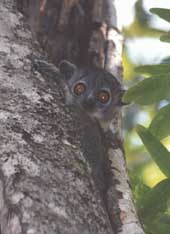Until recently, the sportive lemurs, the only living members of this family, were placed in the lemur family (Lemuridae). Recent research has suggested, however, a close relationship to the extinct giant lemur genus Megaladapis, which is in a separate family, the Megaladapidae. Seven living species are included in 1 genus, Lepilemur, which is found only in Madagascar.
Megaladapidae
sportive lemurs or weasel lemurs
Megaladapis was a very large and unusual animal, weighing 40-80 kg and with a highly elongate skull, more like a pig than any primate. The foramen magnum was rotated back onto the posterior surface of the skull, rotating the head so that it faced forward when the animal stood on four feet. Megaladapis probably fed on leaves; its upper incisors were replaced by a horny pad as in some ungulate herbivores. It may also have had a mobile snout. Zygomatic arches were massive, the braincase was small, and the auditory bullae were flat. Its hands and feet were extraordinarily long, but its legs were relatively short. This suggests it was probably a good climber, but not good at the vertical clinging and leaping style of locomotion common among strepsirhines. It has been suggested that its style of feeding and locomotion was similar to that of a koala.
Superficially, sportive lemurs appear very unlike Megaladapis. They are small to medium sized, weighing 500 - 900 gms. Most are brown or gray dorsally and whitish ventrally. The have relatively short, pointed heads with large rounded ears. Unlike Megaladapis, their feet are only slightly elongated. Their hind limbs are especially long and powerful, and they are adept vertical clingers-and-leapers. Sportive lemurs feed mostly on leaves, also including some flowers, fruit, and bark in their diets. They are basically solitary in their habits, but their densities can be surprisingly high. Males have larger territories than females, and the territory of a male overlaps that of several females. Members of the same sex defend territories against one another, using vocalizations, chases, and even fighting to drive trespassers out. Despite their densities in some areas, sportive lemurs are endangered.
The primary threats to sportive lemurs come from habitat loss and hunting.
HOME
Primates
Primate FAQ
Primate Species
Search Primates.com
Sportive lemur pictures
Primates E-Mail Service
